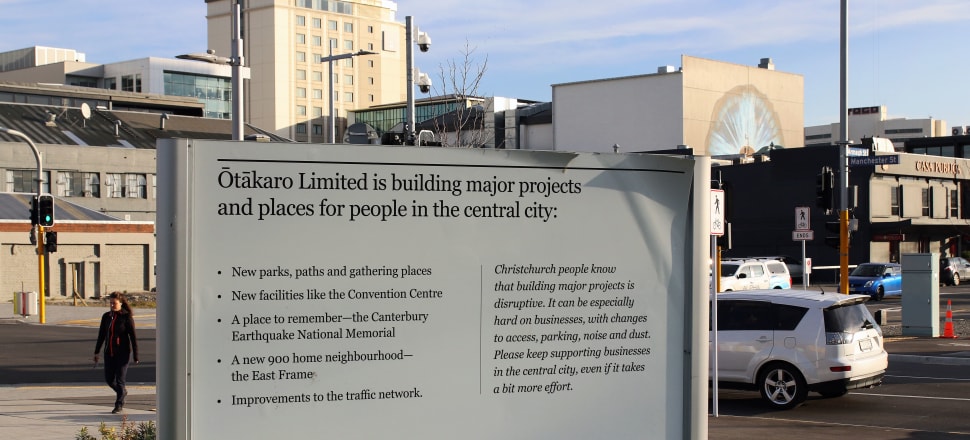
Instead of winding up, the Crown-owned company responsible for big Christchurch rebuild projects like Te Pae convention centre has been handed a new, enduring, nationwide challenge
Cabinet has agreed to repurpose Ōtākaro, its Christchurch rebuild agency, into a new company to deliver infrastructure projects across Government.
Infrastructure Minister Grant Robertson disclosed plans for the new organisation, Central Crown Infrastructure Delivery, with little fanfare, to the Building Nations infrastructure summit in Wellington yesterday. There was no media release. There were no speech notes published.
It is an apparent vote of confidence in an organisation that has picked up the pieces of the late and unlamented Canterbury Earthquake Recovery Authority. "Ōtākaro has a strong record in supporting the regeneration of Christchurch," Robertson says.
The move also implicitly acknowledges the difficulties the Government is facing with big infrastructure budgets blown out by fast-moving construction sector inflation. Robertson emphasised the object of the new company was to ensure projects were delivered in an "effective and efficient way".
Ōtākaro was to have wound up as early as next year, as its existing projects were completed and the Crown land it was selling, to help pay the bills, was all divested. According to its statement of intent for 2023-27, the company was established with the understanding that it had a finite lifespan.
But that changed in September 2021, when ministers quietly advised Ōtākaro's board to taihoa. The company was to continue operations past the end of its current work programme, the board was told, while ministers considered how to best utilise Ōtākaro to support the Government’s infrastructure programme going forward.
The company's path through the pandemic hadn't been an entirely smooth one. It blamed contractor performance for delays to Te Pae, the Parakiore Recreation and Sports Facility, and the Avon River pedestrian bridge. Flooding delayed construction of the Ashburton Library and Civic Building; ground contamination was found on the Bone Marrow Cancer Trust site.
And on the other side of the South Island, its redevelopment of the big, open-cast Stockton Mine was delayed while Ōtākaro talked with the Treasury about how the project would work.
Alongside Christchurch's central city transport projects, the biggest test was Te Pae, the 28,000m2 Christchurch Convention Centre. After four years of construction, the taxpayer-funded project opened in December last year. At that opening, the company’s general manager Keith Beal acknowledged it hadn't been smooth sailing. "An extremely tight labour market and a global pandemic have certainly added to the pressure," he said.
Ōtākaro Ltd is a Crown-owned company that was established in 2016 under the Public Finance Act. Its chief executive is John Bridgman.
According to this year's review by Parliament's finance and expenditure select committee, Ōtākaro recorded a net deficit of $31.5 million for the year. Its total expenditure for the year was $124.5m, an increase of 6 percent from the previous year.
Now, Government agencies the length of New Zealand will be able to engage the new company, Ōtākaro's successor, to use its ‘ready to go’ project team. Robertson says its team will retain knowledge and experience across Crown projects, rather than expending every government department to have its own "standing army" of engineers and project managers.
"This company will work across government to help deliver significant vertical or horizontal infrastructure projects in agencies that do not have this as part of their regular day to day activities," Robertson explains. "The core team will move from project to project taking with them institutional knowledge, best practice and already having key relationships with construction and industry stakeholders."
It won't pick up the biggest infrastructure projects. Government agencies with significant capability financing and building their own infrastructure, like Waka Kotahi, Kāinga Ora, KiwiRail, Education and Health, will be allowed to keep operating independently.
Ōtākaro is already finalising the set of projects it will start working on alongside a number of government agencies, Robertson says. "New Zealand cannot afford to slow down when it comes to the work we're doing on infrastructure. We can't kick the can down the road for future generations to fix the deficit. We must keep going now."
At the same time, Te Waihanga infrastructure commission and Treasury are working on an infrastructure priority list, to be published soon. Robertson says a detailed action plan will be published by Christmas.
There is a clear need for the Government’s infrastructure development to be coordinated to ensure both the delivery and the spending of public funds are efficient, he argues. "The Government has an ambitious infrastructure development programme with everything from roads, prisons, courtrooms and public buildings that need to be constructed and maintained.
"We need to deliver infrastructure, we need to ensure we spend public funds in the most appropriate and transparent way. And we need to ensure that separate Crown projects are not inadvertently disadvantaging each other or putting unnecessary pressure on the sector. This is particularly important in a market of scarce skills and materials."







